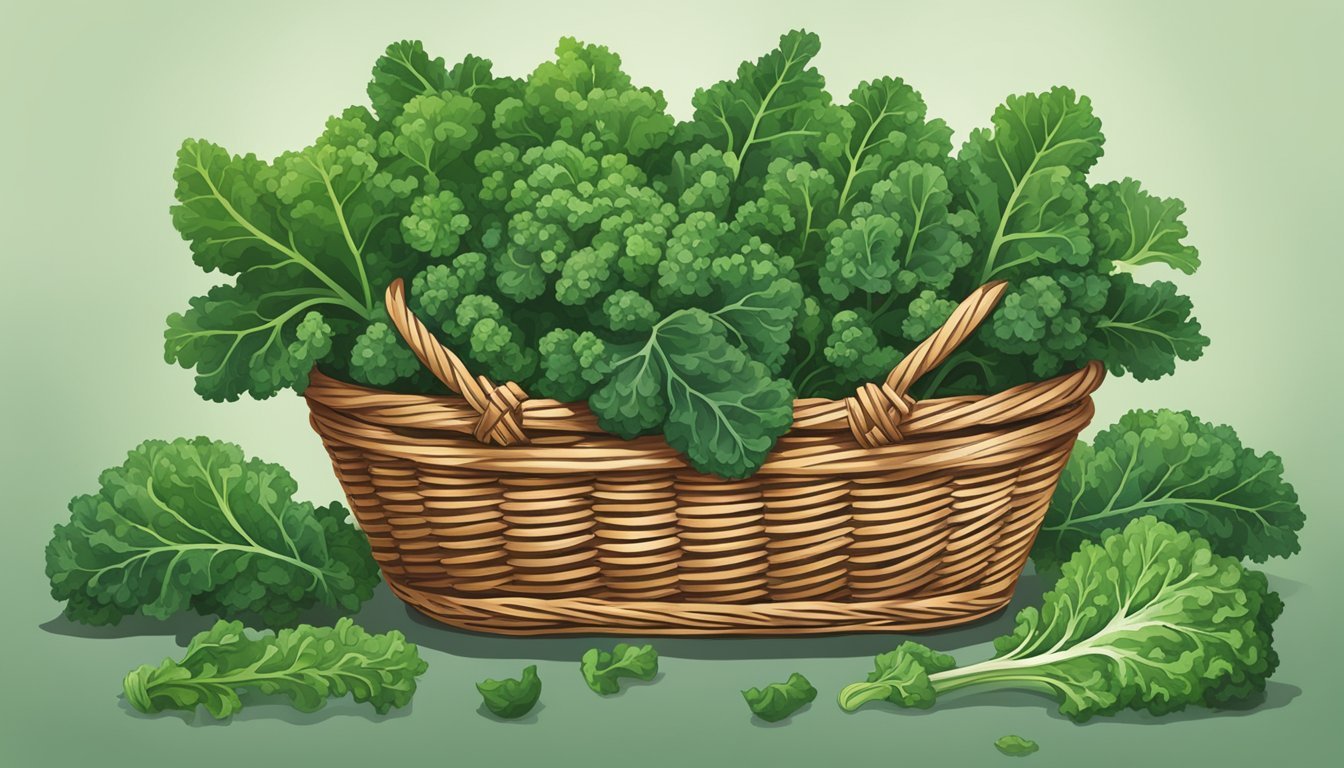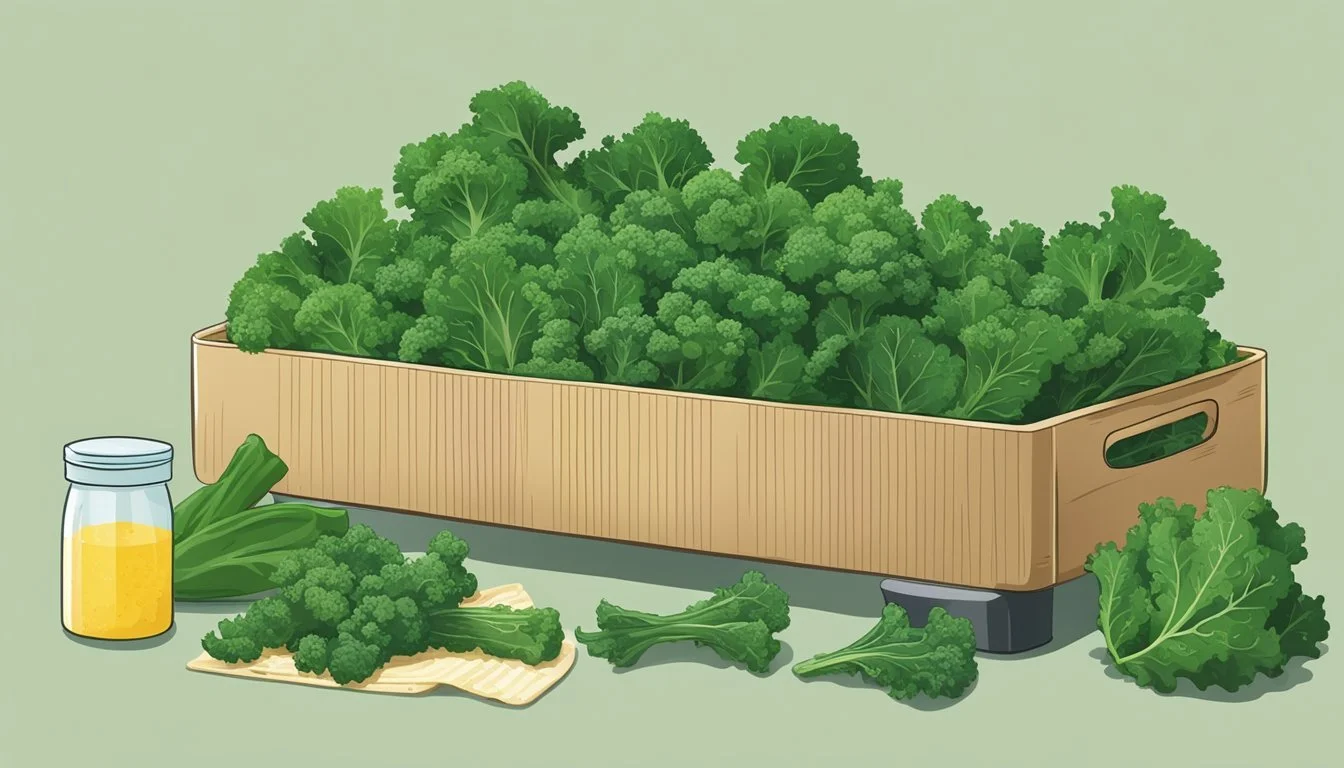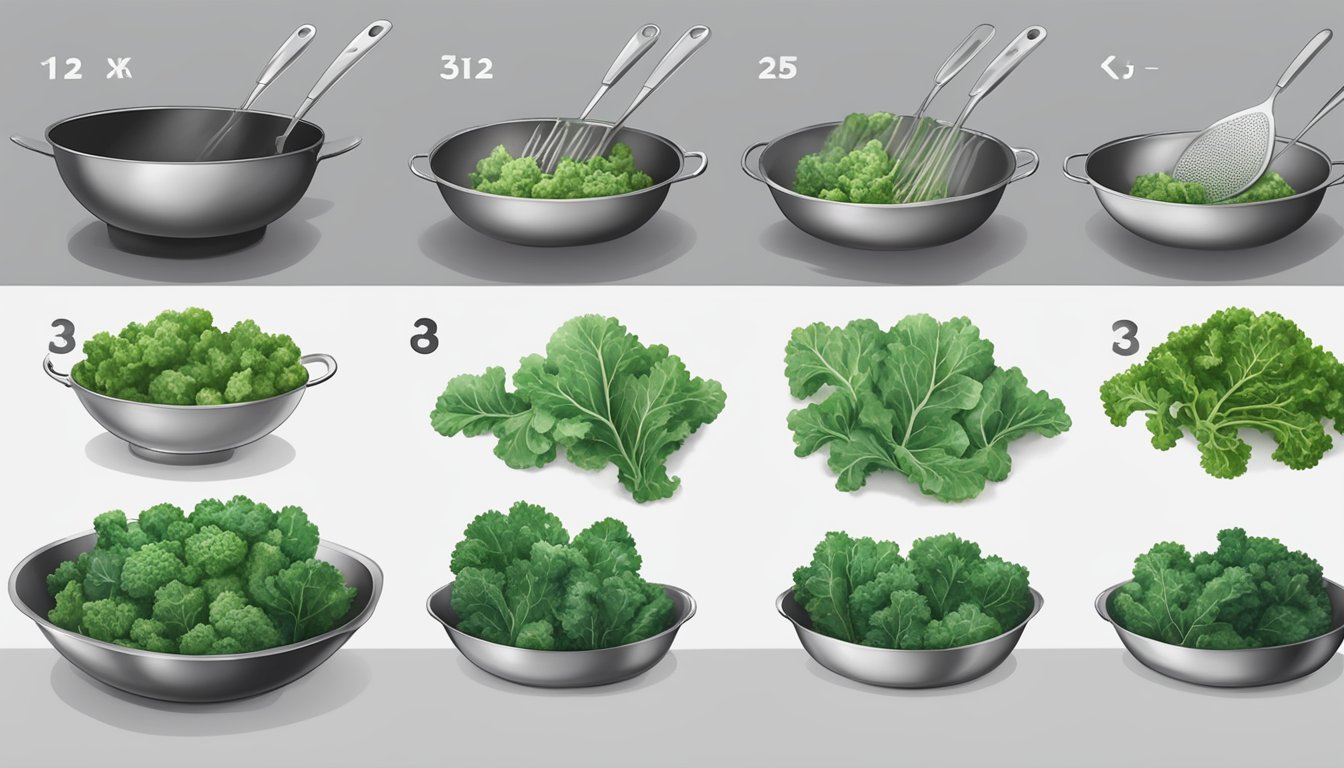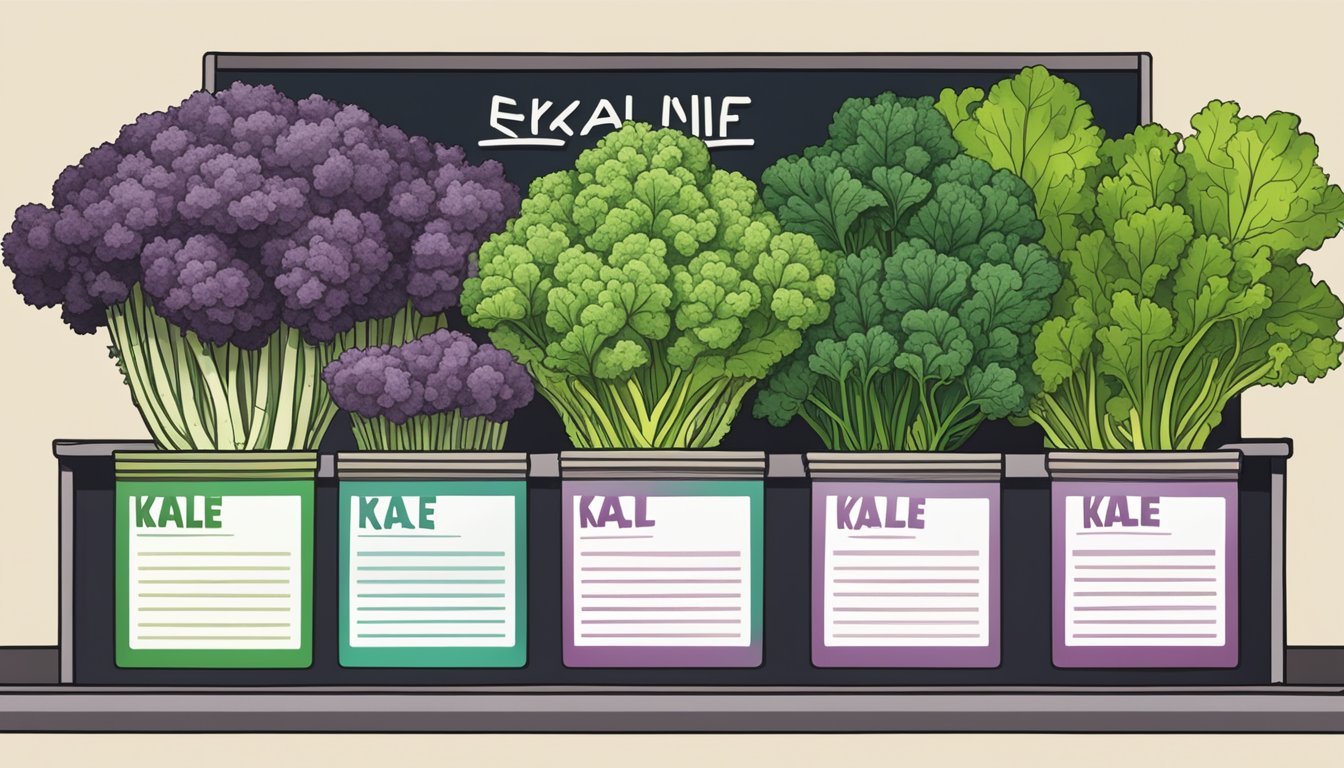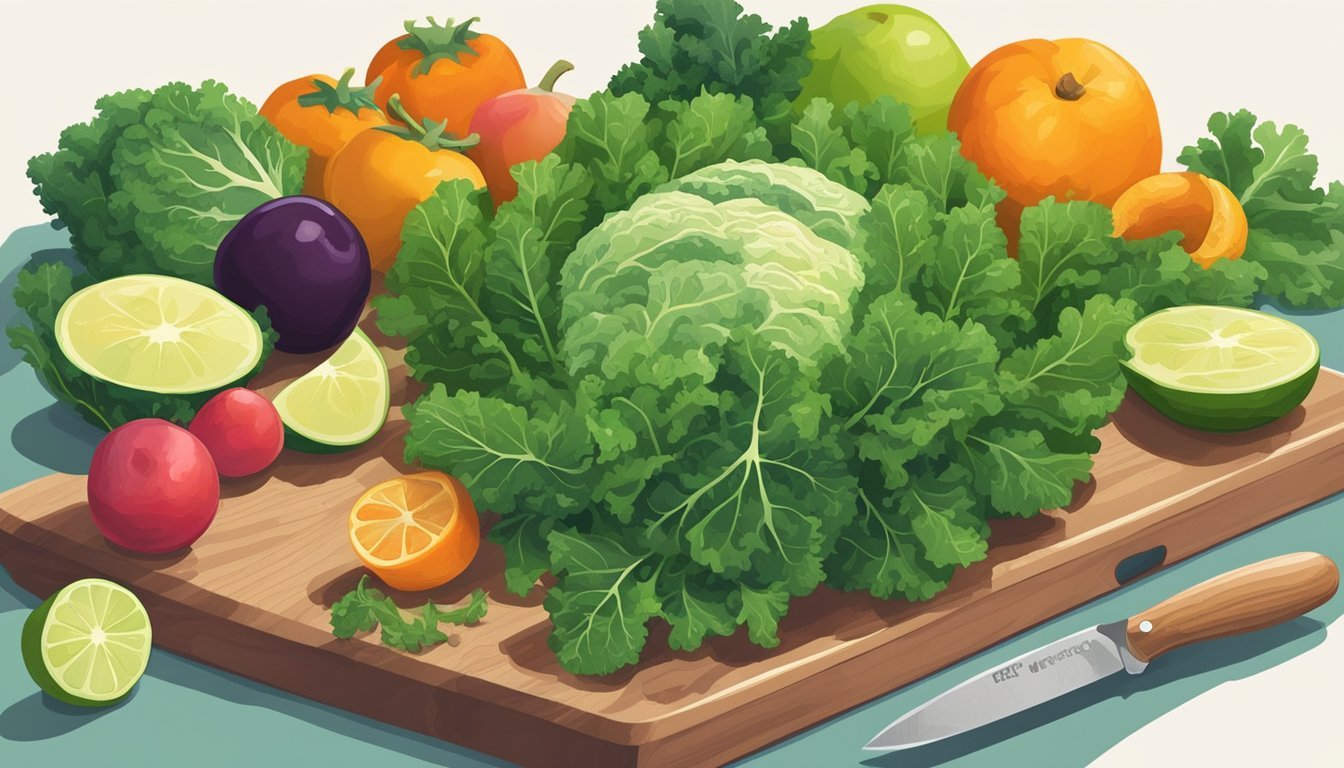How Long Does Kale Last?
Shelf Life and Storage Tips
Kale, (What wine goes well with kale?) as a nutrient-dense leafy green, has gained a reputation for its health benefits and culinary versatility. Understanding how to properly store kale is crucial in maintaining its freshness and extending its shelf life. Typically, when stored in a refrigerator's crisper drawer, kale can remain fresh for about five to seven days.
For those who purchase kale in bulk or cannot consume it quickly, freezing serves as a reliable preservation method, allowing the vegetable to last for up to 8 to 12 months. Correct storage techniques, which include keeping the kale dry and using air-tight containers or bags, play a significant role in preventing spoilage and waste. Signs of kale going bad include yellowing leaves, a wilted texture, and an off smell.
Identifying Fresh Kale
When selecting kale, certain indicators ensure its freshness. These include the appearance, texture, and scent, which are all essential to determining the quality of the leafy green.
Visual and Texture Cues
Fresh kale should have vibrant, deep-colored leaves with sturdy stems. The leaves should look perky and not limp. One should inspect the leaves for the following signs:
Color: Look for dark green or purple tones, avoiding yellow or brown spots.
Texture: Expect crispness to the touch; any wilting or softness often suggests age or improper storage.
Wilting: If leaves show signs of drooping, they are likely past their prime.
Spoilage: Kale showing signs of spoilage, such as brown or yellow discoloration, should be avoided. Moreover, any presence of mold, which appears as fuzzy spots on the leaves or stems, indicates that the kale is no longer good for consumption.
Smell and Taste Evaluation
The scent of fresh kale should be mildly herbal or grassy, not sour or off-putting. Spoiled kale may emit an unpleasant, sulfur-like smell. To check for freshness:
Smell: Bring the kale close to the nose and take in the scent, ensuring it is not unpleasant or pungent.
Taste: If appearance and smell are inconclusive, one may taste a small piece of kale—fresh kale should taste slightly bitter with earthy notes, not overly sour or off.
By using these guidelines, one can confidently select fresh kale, ensuring they are bringing home a quality vegetable that will be a nutritious addition to their meals.
Optimal Storage Methods
Proper storage can dramatically extend the lifespan of kale, maintaining its freshness and nutritional value. Employing the correct techniques in the refrigerator or freezer ensures kale stays crisp and enjoyable for longer periods.
Refrigerator Storage Tactics
In the refrigerator, kale should be kept in the crisper drawer to optimize its environment for freshness. The drawer offers a more stable temperature and humidity level that's ideal for kale. The key points for storing kale in the refrigerator are:
Dryness: Ensure that the kale is thoroughly dry before storing it to prevent excess moisture from spoiling the leaves. A salad spinner can be effective in removing excess moisture.
Paper Towels: Line a plastic bag with paper towels to absorb any residual moisture, which helps to keep the kale fresh and crisp.
Air Removal: When placing kale in a plastic bag, squeeze out as much air as possible before sealing to minimize oxidation.
Orientation: Position the stems toward the back of the fridge, where it's typically colder, to preserve freshness.
Step Description 1. Dry kale Use a salad spinner or pat down with paper towels. 2. Bag prep Line a plastic or freezer bag with paper towels. 3. Pack kale Place kale in the bag, remove excess air, and seal. 4. Refrigerate Put the bag in the crisper drawer for optimal storage.
Long-Term Freezing Techniques
For longer storage, freezing kale is an effective method. It can be preserved for several months by following these steps:
Blanching: Blanch the leaves in boiling water for 2-3 minutes to preserve color, flavor, and nutritional content, then cool immediately in ice water.
Drying: After blanching, dry the leaves thoroughly using a salad spinner or by patting them dry with clean towels.
Freezing Prep: Arrange the dry kale leaves in a single layer on a baking sheet to freeze them quickly and evenly.
Storage: Once frozen solid, transfer the kale to airtight freezer bags, removing as much air as possible before sealing to prevent freezer burn.
Step Description 1. Blanch Submerge kale in boiling water, then cool in ice water. 2. Dry Dry thoroughly with towels or a salad spinner. 3. Freeze Lay leaves on a baking sheet in a single layer and freeze until solid. 4. Bag and Seal Transfer to freezer bags, remove air, seal, and store in the freezer.
Storing kale properly in the refrigerator or freezer ensures that the leafy green remains a versatile and nutritious addition to meals for extended time periods.
Maximizing Kale Shelf Life
Proper storage methods can extend kale's shelf life, keeping it fresh and preventing the leaves from becoming wilted or spoiled. With careful attention to moisture control, temperature regulation, and prevention of cross-contamination, the longevity of kale can be significantly improved.
Moisture Control
Dry Kale Thoroughly: After rinsing kale in ice water to refresh it, one should use a salad spinner or pat the leaves dry with paper towels.
Paper Towel Method: Wrapping the kale in a dry paper towel before placing it in storage can absorb excess moisture, preventing the leaves from becoming soggy.
Temperature Regulation
Refrigeration: Store kale in the crisper drawer of the refrigerator, ensuring the temperature is not too cold to cause freezing but enough to slow down decay.
Freezing: For long-term storage, kale can be frozen. Freeze individual leaves on a tray and then transfer to a freezer bag to prevent clumping.
Preventing Cross-Contamination
Separate Storage: Keep kale separate from ethylene-producing fruits and vegetables, as ethylene can accelerate spoilage.
Airtight Containers: Use airtight containers or zip-top bags to protect kale from circulating bacteria and odors in the refrigerator.
Preparation and Usage of Kale
When preparing kale, one must focus on proper washing and cutting techniques to ensure the leafy greens are clean and best suited for their intended dish, whether it be salads, chips, or other kale recipes.
Washing and Drying Techniques
Properly washing kale is crucial for removing debris and preventing wilt. The leaves should be submerged in a bowl of cold water and agitated to dislodge dirt. After removal with a slotted spoon, the kale should be thoroughly rinsed under running water in a colander. Drying techniques involve using a salad spinner to remove excess moisture or patting the leaves dry with paper towels.
Submerge kale in cold water.
Agitate to loosen debris.
Rinse thoroughly in a colander.
Dry with a salad spinner or paper towels.
Cutting and Prepping for Dishes
Once the kale is clean and dry, it's time to cut the leaves. Removing the stems, which are tougher and less palatable, ensures a better texture, particularly for raw preparations like kale salads. Cutting the leaves into 1/2" to 1" pieces is generally recommended, though the size may vary depending on the recipe.
Remove stems: They can be stripped easily by hand or with a knife.
Chop leaves: To desired size for the dish.
These preparation steps ensure the kale is in optimal condition for cooking or raw consumption, giving it the fresh texture and taste that is desirable in dishes like crisp kale chips or hearty kale salads.
Freezing and Blanching Kale
Freezing kale is an excellent method for extending its shelf life while maintaining its nutritional value. Blanching kale prior to freezing is crucial, as it deactivates enzymes that can cause loss of flavor, color, and texture.
Step-by-Step Blanching Process
One begins the process of blanching kale by washing the leaves thoroughly. They should then tear the kale into bite-sized pieces, discarding the stems. The next step involves bringing a large pot of water to a boil. Once the water is boiling, one immerses the kale for approximately 2.5 minutes to deactivate the enzymes.
Immediately after, the blanched kale is transferred to a bowl of ice water to halt the cooking process rapidly. This step ensures the leaves retain their vibrant color and nutrients. After cooling for the same amount of time as the blanching, the kale must be drained thoroughly to remove any excess water.
Storing Blanched Kale for Freezing
For effective freezing, one should spread the kale out on a baking sheet and freeze it for 2-3 hours. This step prevents the leaves from clumping together. Once individually frozen, the kale pieces can be consolidated into freezer-safe bags or containers. The air should be pressed out of bags to minimize freezer burn.
The properly blanched and stored kale can last in the freezer for up to six to eight months, providing an easy-to-use supply of greens for future recipes.
Thawing and Using Frozen Kale
Thawing frozen kale properly ensures its texture and nutrients are retained, making it an ideal ingredient for various recipes. From smoothies to stews, the proper handling of kale is crucial for achieving the best results.
Thawing Techniques
There are a few techniques for thawing frozen kale:
Refrigerator Thawing: Transfer the frozen kale to the refrigerator and let it thaw overnight. This method preserves texture and flavor and is best when the kale is going to be used in cooked dishes.
Cold Water Thawing: Place the frozen kale in a sealed plastic bag and submerge it in cold water. Change the water every 30 minutes. This method is quicker but requires attention.
Microwave Thawing: Using the defrost setting, thaw the kale in short intervals, stirring in between to ensure even thawing. This is the fastest method but may slightly cook the edges of the kale.
Incorporating Frozen Kale into Recipes
Frozen kale can be incorporated directly into various recipes, making meal preparation convenient:
Smoothies and Green Smoothies: There’s no need to thaw kale for smoothies. Use it straight from the freezer to keep the drink cold and add a rich, green color.
Soups, Stews, and Casseroles: Add frozen kale directly to these hot dishes during cooking. The heat will thaw and cook it simultaneously.
Cooked Kale Dishes: For dishes where kale is the primary ingredient, it’s best to thaw it first using one of the above methods, then sauté or cook as desired.
In all cases, ensure that excess water from thawing is removed to prevent watering down the recipes.
Kale Varieties and Selection
When selecting kale, one must consider the variety which impacts flavor and texture, as well as the quality of the leaves—looking for freshness and vitality.
Different Types of Kale
Kale comes in numerous varieties, each with unique characteristics. Curly kale is perhaps the most common, with ruffled leaves and a peppery, robust flavor. Red kale, also known as Red Russian kale, has a slightly sweet and earthy taste with a hearty texture. It's easily recognizable by its red-tinted leaves and stems. Dinosaur kale, or Tuscan kale, is known for its long, bumpy leaves that have a somewhat sweeter taste compared to its curly counterpart.
Curly Kale: Peppery, vibrant, ruffled leaves
Red Kale (Red Russian): Slightly sweet, earthy flavor, red-tinted leaves
Dinosaur Kale (Tuscan Kale): Sweeter taste, long and bumpy leaves
These types are commonly found in gardens, supermarkets, and farmers' markets. Organic options are also available, catering to those looking for produce grown without synthetic pesticides or fertilizers.
Selecting the Best Kale at Stores
When selecting kale at the supermarket or farmers' market, freshness is the key indicator of quality. Look for kale leaves that are firm and deeply colored with no signs of wilting or yellowing. Organic kale may have a higher nutrient profile, which some consumers prefer. In all cases, the leaves should be free from small holes or tears that might indicate insect damage or decay.
Look for firm, brightly colored leaves
Avoid wilted, yellowing, or damaged leaves
Consider organic options for a potentially higher nutrient profile
Remember, fresher kale will not only taste better but is also likely to last longer once stored properly at home.
Health Benefits and Nutritional Information
Kale, considered a superfood, is prized for its nutrient density, offering a wealth of vitamins and minerals alongside beneficial fiber. It fits readily into a health-conscious diet and brings a range of benefits befitting its status as a powerhouse vegetable.
Kale as a Superfood
Kale is renowned for being a superfood due to its high concentration of nutrients packed into a low-calorie profile. It is part of the cruciferous vegetable family, which is known for plants that contribute positively to health. A single cup of raw kale not only has a mere 7-10 calories, but it also contains significant amounts of fibrous content, essential to support digestive health.
Vitamins and Minerals in Kale
The vitamins and minerals in kale underscore its superfood designation:
Vitamin A: Over 20% of the recommended daily intake per cup, crucial for vision and eye health.
Vitamin K: Abundant in kale, important for blood clotting and bone health.
Vitamin C: A powerful antioxidant, with a significant amount present in kale to support immune function.
Calcium: Essential for bone health and muscular function, kale provides a good plant-based source.
Potassium: Important for heart health and electrolyte balance, kale includes a noteworthy amount.
Moreover, the inclusion of kale in the diet aids in the provision of fiber and has a link to improved heart health through its phytonutrient content, underpinning its reputation as a superfood.


